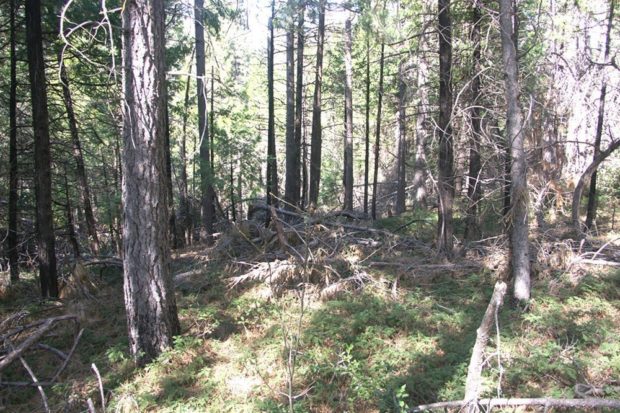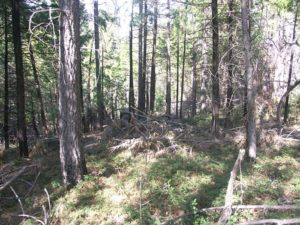
By Chip Ashley
Long before it was called North Fork, it was called Wa-up by the Mono people that inhabited the area and used what nature provided with respect for the Earth—they used it sustainably. Native people lived there for thousands of years, gathering acorns and pine nuts and hunting deer and elk. It is a pleasant place, with relatively level areas for lodges and a beautiful stream—Willow Creek—running among ponderosa pines and black oaks.

When the first settlers came in the 1850s, they were interested in wealth, not sustainability. The first attraction was gold, but the greedy newcomers soon discovered the real wealth was in timber, so the town became a lumber mill town, harvesting the tall ponderosa and sugar pine as fast as they could fell them and mill them to feed the building frenzy in the growing San Joaquin Valley.
The first mill was established in 1888—the North Fork Lumber Company. So the name was changed from Brown’s Place (after a settler) to North Fork. Associated Lumber and Box took over in 1942. In turn, the mill was owned by “American Forest Products, South Fork Timber Industries, and finally Sequoia Forest Industries.” It “was at times the largest industry in Madera County. Employing some 200 people, and with an annual payroll of more than $1 million, it was the life blood of the town” (Sierra News Online).
Due to the awakening of an environmental consciousness in the 1970s and consequent law—often based on what current research now views as flawed science, particularly the science surrounding the northern spotted owl—severe limits were placed on the timber harvest. Big ponderosa and sugar pines take more than a hundred years to reach the size desired by lumber companies, and large trees were getting scarce. Most of the accessible old growth had been logged, and environmentalists—with good reason—wanted the remaining old growth preserved. So Sequoia Forest Industries milled its last log in 1993.
With the mill’s closing, North Fork lost its main economic base. As North Fork Community Development Council president Dan Rosenberg puts it, North Fork was in serious economic trouble long before the current national recession. “North Fork was already hit and down.” Unemployment in the community has hovered around 20% since the shutdown of the mill.
But the community learned the hard lesson of sustainability. These folks love their community and their valley surrounded by piney peaked mountains. They want to sustain it—keep it good indefinitely for everybody in it and everything around it—the raccoons, the spotted owls, the red-legged frogs and pacific fishers, as well as the human community.
One example of sustainable imagination in North Fork is a plan to build a small-scale one-megawatt woody biomass electrical generation plant on the old mill site. According to community leaders, this plant would supply clean sustainable energy and heat to local residences and businesses and create badly needed jobs.
Rosenberg says that when he first moved to North Fork in 1998 after 10 years in Greenwich Village and Haight-Ashbury, he “cringed” when he saw a logging truck rolling through town (on the way to the single remaining southern Sierra mill in Terra Bella). “Oh my God!” he would say to himself. “They’re going to cut down every tree!”

But Rosenberg discovered that the issue wasn’t so cut and dried. Forests and forest communities are involved in complex social, economic and ecological issues that current research is revealing are not as polar as spotted owl versus logger. Gradually, the excesses of both logging and environmentalism have been exposed, and now logging and sustainable forests—with plenty of room for spotted owls and other species, including people—are compatible. Current research is reflected in the federal Forest Landscape Restoration section of Title IV of the Omnibus Public Land Management Act of 2009 and the new federal Forest Planning Rule (2012).
So current planning is better informed and inclusive—all well and good. But before North Fork could do anything with the mill site, residents had to clean up the brown field left when the mill shut down. According to Rosenberg, the cleanup took 14 years and more than $2 million. Much of the funding came from federal and other grants, many written by Elissa Brown, a funding expert who represents the Sierra Nevada Conservancy, a small California state agency in the Natural Resources Department that has been working with North Fork for more than a decade. Also with the conservancy, Executive Director Jim Branham, Mandy Vance, Kim Carr and Nic Enstice have been critical to these efforts.
The Yosemite Sequoia Resource Conservation and Development Council, headed up by Auberry’s Steve Haze, has obtained federal grants under the U.S. Department of Agriculture’s Woody Biomass Utilization Program to fund planning for the biomass project.
For fuel, the plant would use forest biomass removed from the surrounding Sierra National Forest in projects designed for ecological restoration and fuels reduction, part of the new adaptive management policies noted above.
Unlike a conventional wood-burning boiler, this plant will not burn wood. It will not emit smoke or particulates or much of any other sort of air pollutants we are wary of in the San Joaquin Valley. It will emit a small amount of NO2 and NO (oxides of nitrogen, aka NOx), ozone precursors. But in this technology, NOx is well under the legal limits. For example, a similar project already up and running in Merced has never been sanctioned for air pollution.
If not used to fuel this plant, the forest thinnings would be piled and burned, contributing much more pollution, including particulates, NOx and climate warming greenhouse gases. Furthermore, more frequent uncharacteristically severe forest fires would contribute massive amounts of pollutants and greenhouse gases during the summer and fall, when Valley air is at its worst.
The plant works by heating wood chips (1300° F) with limited oxygen, releasing volatile gases, which are captured, refined and used as fuel to run an electrical generator. Voila! Renewable natural gas, also called “syngas” and “biogas”—a huge improvement over fossil natural gas.
Combustion of biogas releases CO2. But there is a big difference between the CO2 emitted from this plant and the CO2 emitted from facilities using fossil natural gas. Extraction of fossil gas takes safely sequestered carbon from the earth and adds more and more “new carbon” to the atmosphere. Combustion of renewable natural gas adds no new carbon to the carbon cycle (carbon moving back and forth between the atmosphere and living organisms through photosynthesis and organic decomposition, of which combustion of carbon based fuels is one form). Combustion of renewable natural gas contributes no net carbon.
Perhaps the most significant use of this charcoal is as “biochar”—charcoal that can be added to carbon-depleted soils, improving water and nutrient retention. Moreover, biochar is composed of tiny pores separated by carbonized cell walls, providing microscopic nooks and crannies to house important soil organisms that work symbiotically with plants and crops to help them grow.
Biochar sequesters carbon. Heat turns the carbon in the wood—wood is approximately 50% carbon by weight, with the remaining 50% composed of oxygen and hydrogen—to an oxidation-resistant form of carbon called aromatic carbon. So the biochar technology uses trees and plants (photosynthesis) to pump climate-warming carbon dioxide out of the atmosphere back down into the earth where it helps plants grow instead of warming the planet. Climate advocate Bill McKibbon has likened biochar to “undrilling oil” and “unmining coal.”
McKibbon has also warned biochar proponents to take measures to ensure that this technology does not lead to deforestation. Biochar groups like the International Biochar Initiative and the U.S. Biochar Initiative, which are quite “green,” take McKibbon’s caveat seriously. They recommend that fuel stocks for biochar facilities be restricted to existing waste streams. Think of what this could mean in terms of diverting green waste from landfills.
But there are questions. In a recent review of 212 publications, the Union of Concerned Scientists (UCS) has questioned the claim that biochar effectively sequesters carbon. “Insufficient data exists…to assess biochar’s stability over long time periods. Biochar is only effective as a climate change solution if it remains stable in the soil for many years.”
However, of the studies UCS cited that actually measure sequestered carbon, four of six find that most of the carbon added to soil remains sequestered after 293 years. One gives a figure of greater than 1,000 years, another more than 3,600 years.
One indication that biochar can be an effective means of carbon sequestration is terra preta, referring to dark anthropogenic (human-made) soils in the Amazon Basin. Landscape archaeologist Clark Erickson has produced a superb documentary film, The Secret of El Dorado, about the production of these soils by an ancient Amazonian civilization. Terra preta soils consist of several feet of dark topsoil, rich in carbon. Native Americans produced these soils over perhaps a thousand years or more.
Uncertainties remain. But these are the kinds of questions a demonstration project like the one in North Fork can help answer. And this attempt to answer such important questions puts tiny North Fork at the forefront of the sustainability movement and the struggle against climate change.
*****
Chip Ashley is a local environmental activist and member of the Tehipite Chapter of the Sierra Club. Contact him at 559-855-6376 or wattsvalleypreservation@gmail.com.
